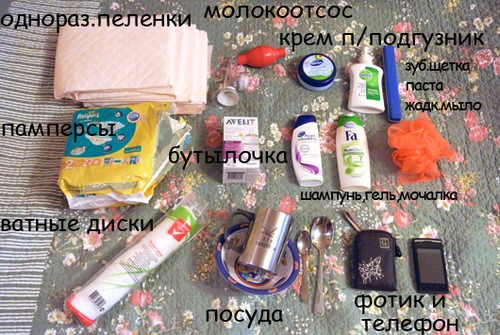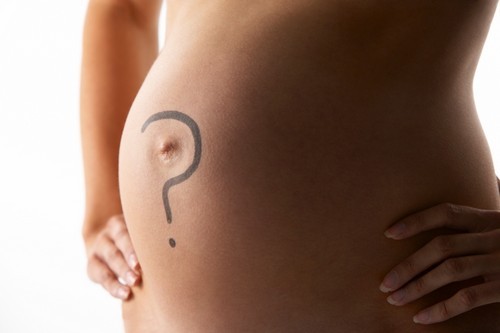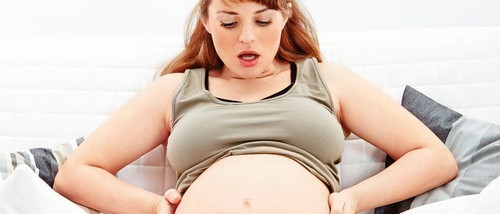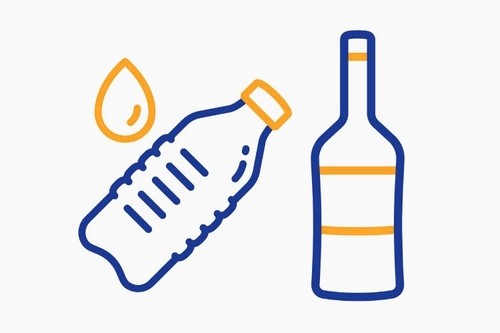The size of the fetus at the thirty-fourth week of pregnancy increased markedly. Now his height can reach 45 cm. In the following weeks, this figure will increase by another 5-10 cm. The weight of the child at 34 weeks of gestation exceeded 2 kg.
Larger babies can weigh 2.3 kg.
If a previously born fetus would be considered premature, then born now, they will call it already prematurely born.
Characteristic features of the child’s appearance
The baby is becoming more and more like a newborn. Those who do an ultrasound at this time may notice that his cheeks have become rounded. This is due to the fact that the baby often sucks a finger. Such movements develop well facial muscles. Thus, there is a kind of preparation for eating after birth.
Hair continues to grow on the baby’s head. Thanks to the pigment, they acquire a certain color. But it often happens that with age, they later change color.
The ears of the baby took their place and have a slightly protruding appearance.
The skin has become even denser. Redness disappears, and its color turns pink. As the accumulation of subcutaneous fat continues, the skin becomes smoother. Also, due to the increase in the baby’s tummy, the navel takes its usual place.
Cannon hairs become even smaller, and the amount of original lubrication is still large. The main place of its localization is skin folds.

Now the baby has become completely different from the others – he has formed individual fingerprints and lines on the palms of his hands. The child’s nails are well grown and already extend beyond the edge of the finger.
Changes in systems and organs
The development of the fetus at 34 weeks of gestation is mainly aimed at improving systems and organs:
- Digestive system. The gastrointestinal tract is formed. His main goal now is constant training. This is possible due to the fact that the baby swallows amniotic fluid. Accordingly, this process also helps with kidney training. For a day they remove from the fetus up to half a liter of urine;
- Bone system. Due to the ongoing strengthening of the skeletal system, an expectant mother should consume enough calcium during the thirty-fourth obstetric week of pregnancy. If it is not enough in your diet, the doctor will prescribe special medications. Calcium should not be abused either, as too strong bones can lead to birth injuries. The bones of the skull remain soft and mobile. This is very important for the passage of the fetus through the birth canal. After birth, you will be able to feel on the baby’s head a small pulsating groove – the fused skull bones, called the fontanel. In the first year of life, the fontanel will gradually “heal”;
- Respiratory system. The baby’s lungs have already formed, enough substance has been released that helps the alveoli not stick together (surfactant). In the case of premature birth, the baby is most likely to be able to breathe on its own;
- Hearing changes. Despite the fact that the baby has long been hearing and distinguishing sounds, it is important to understand what happens at 34 weeks of gestation. Now the baby can not only distinguish the voices of loved ones, but also reacts to their intonations. By the way his relatives communicate with his mother, the baby understands who is friendly and who should beware;
- The genitals. Usually at this time, the testicles descend into the scrotum in boys. However, there are exceptions, so it is possible that this will not happen at the time of birth. Do not worry, then this will happen during the first year of life.
The position of the fetus inside the uterus
In most cases, the fetus is already head down. This is considered the optimal position for childbirth. Since the baby reacts to any stressful situation in your life, try to avoid unnecessary worries. An excited baby may roll over and take a not-so-good position.
In the case of pelvic presentation, doctors most often recommend a cesarean section.
But quite a few women successfully gave birth to such babies on their own. In addition, there are certain exercises that contribute to the natural revolution of the fetus.
Pregnancy and mother’s body
Thirty-fourth week of pregnancy is hard for many mothers. More and more fatigue appears. Walking even not very far distances can cause shortness of breath, pain in the back and legs.
Unpleasant Pregnancy Symptoms
The expectant mother has the following symptoms at 34 weeks of gestation:
- False contractions. They begin at the top of the uterus, then fall down the abdomen. Although such contractions can be painful, they are easy to cope with. It is enough to take a warm shower and lie down to rest;
- Of the enlarged mammary glands, it can oozing colostrum;
- The frequency of movements decreases due to the lack of space for the fetus in the uterine cavity;
- Swelling. May appear on hands, feet, face;
- Lowering the fetus. Usually occurs shortly before birth. After that, it will become much easier to breathe;
- Pain in the back, lower back, stomach. The reason is an enlarged uterus;
- Insomnia. Perhaps changing your posture for sleep will make it easier to fall asleep. Doctors also recommend not eating or drinking before bedtime;
- Frequent urination;
- Itchy skin. Any part of the body can scratch. This is not an indicator of a terrible disease that is dangerous for mom or baby. However, of course, you need to tell the doctor about your condition. He will help you choose an antiallergic drug, taking into account your situation.
Physical sensations and advice from doctors
They are associated primarily with the movements of the baby. The fetus at 34 weeks of pregnancy does not move so actively. However, the lack of stirring should alert the future mom at all.
Doctors recommend fixing the number of movements. Normally, the baby makes itself felt 10 times over 12 hours. At rest, mothers, in an hour their number should be at least 4.
Moreover, each movement of the baby can respond with pain in different places. Since the child does not have enough space, he “clears” his way with his hands and feet, so he can get his mother’s ribs, liver, and intestines.
It is extremely important to monitor the activity of the baby, because this is one of the main indicators of his physical condition. Also, by moving it is possible to judge the psychological comfort of the crumbs. For example, his activity changes if he is frightened, a bright light or loud music annoys him.
Emotional state and excitement
34 weeks of pregnancy is a period of great experiences. They are caused by fear for the baby. And since the time of birth is fast approaching, the woman is also worried about how they will pass.
The most important thing now is to keep calm and get more positive emotions. After all, the baby feels great mother’s condition!
Relatives, friends or husband can help cope with your worries. A visit to a theater, museum or exhibition also helps to get distracted and have a good time.
But from going to the cinema and concerts it is better to refrain. Loud sounds can scare the baby. But how wonderful it is to watch a fun family movie at home with your husband or friends.
Dimensions of the abdomen and uterus
The growth of the abdomen does not stop, because the usual clothes are already clearly small. From the beginning of pregnancy, the uterus increased in size by 500 times, and by weight – 10 times.
The height of the bottom of the uterus is approximately 14 cm above the navel. By the way, with an increase in the size of the abdomen, many note that the navel becomes turned outward. In normal condition, he will gradually return after childbirth.
Also, some women note the appearance of a dark band that divides the stomach into two halves. She will also disappear after childbirth.
This is how the tummies look at 34 weeks of gestation:

Medical Examinations at Week 34
Meetings with the doctor will now occur every two weeks. On them, as before, the doctor will measure your weight, blood pressure, uterine fundus and abdominal circumference. Before each visit, it is important to take a urine test in order to recognize the likely gestosis (a condition dangerous to the mother and fetus) in time.
What tests should be taken
At this time, as a rule, no special analyzes are prescribed. Pregnant women only traditionally give blood and urine for analysis.
In some cases, the doctor may prescribe a re-analysis for the Wasserman reaction. More information at 34 weeks of gestation can be obtained using ultrasound and cardiotocography (CTG).
Ultrasound and its results
By this time, usually the majority of pregnant women have already passed the third elective ultrasound examination. However, according to the testimony, the doctor may prescribe a second procedure.
Through ultrasound at the thirty-fourth week of pregnancy, the doctor will determine the approximate weight of the baby, will conduct basic measurements of the fetus. The procedure will help to understand how the development of the child is going, whether it corresponds to the deadline. Also, by conducting dopplerometry, it is possible to determine whether the circulatory system works well, whether the baby receives enough oxygen. Ultrasound will clarify what position the fetus occupies.
As always, special attention will be paid to the placenta. Deviations from the norm in terms of wall thickness and degree of maturity will indicate various deficiencies. Such complications will require some treatment.
For childbirth, information on the quantity and condition of the waters, as well as on the presence of cord entanglement, will be useful.
CTG procedure to evaluate heart function
A cardiotocogram allows you to evaluate the work of the baby’s heart, its motor activity and reaction to uterine contractions. During CTG, two sensors are connected to the stomach of a pregnant woman, which will record all changes that occur with the baby.
Cardiotocography is not dangerous for either mom or baby.
Possible complications at week 34
Although the delivery at this time will end in almost 100% of cases successfully, you still need to try to avoid complications. These include:
- Late toxicosis. A sudden change in blood pressure by 5 mm Hg should alert. Art. relatively normal indicators;
- Due to the active effect of hormones on the body, bleeding of the gums or their inflammation, plaque on the teeth can occur. There is still time to see a dentist. Untreated diseases can infect a newborn;
- Premature birth. Several factors can cause them: age, poor nutrition, stress, physical labor, varicose veins. The fact that they began can be found out by the departed waters and fights. It is important to be able to distinguish them from false. If each time the duration of the contractions increases, and the time interval between them decreases, then it is time to talk about the onset of labor. Delivery at the 34th week of pregnancy, although they will be prosperous, but it is better to go to the hospital as soon as possible;
- Various discharge. Purulent – indicate infection, bloody – about placental abruption, transparent liquid – about water leakage.

Essential supplies for the expectant mother
Recommendations for the expectant mother
- Particular attention should be paid to nutrition. No matter how hard it is, you should refrain from soothing food in the form of sweet and starchy foods. It is better to include more meat, fish, vegetables, cereals, dairy products in the diet. It is advisable to use less salt to avoid swelling;
- Since, in addition to visible edema, there are also hidden edema, it is advisable to conduct daily diuresis. It will help determine the amount of fluid consumed and excreted from the body. If nevertheless edema has appeared, it will be useful to start arranging fasting days. They can be apple, and curd and other;
- At week 34, doctors recommend abstaining from sex. This is due primarily to the risk of introducing the infection into the vagina. Also, sex can provoke the baby to roll over and take up not the best position for childbirth;
- Already now you can decide in which hospital the delivery is planned, as well as find out in advance a list of things for mom and baby;
- When collecting things, it is worth considering that some maternity hospitals require that they be packed in transparent bags;
- Documents are already desirable to collect and put in one place. Leaving home, it is better to take a folder with them. It must include: passport, SNILS, compulsory medical insurance policy, exchange card with all the analyzes and results of the procedures. Also, a reconciliation with a TB dispensary should be entered in the exchange card.
This material is for informational purposes only, before using the information provided it is necessary to consult with a specialist.



